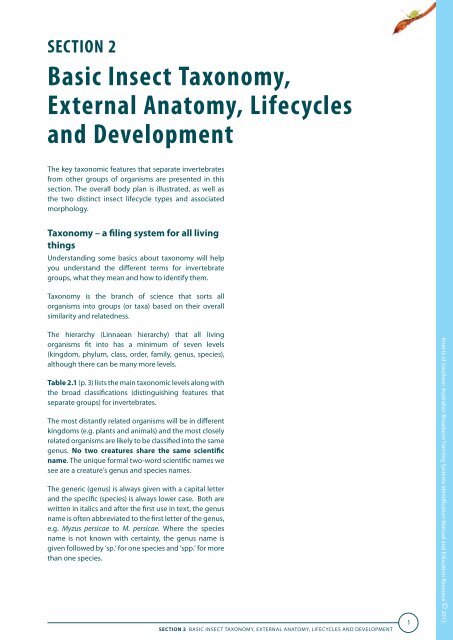Insects of Southern Australian Broadacre Farming Systems - Grains ...
Insects of Southern Australian Broadacre Farming Systems - Grains ...
Insects of Southern Australian Broadacre Farming Systems - Grains ...
You also want an ePaper? Increase the reach of your titles
YUMPU automatically turns print PDFs into web optimized ePapers that Google loves.
SECTION 2<br />
Basic Insect Taxonomy,<br />
External Anatomy, Lifecycles<br />
and Development<br />
The key taxonomic features that separate invertebrates<br />
from other groups <strong>of</strong> organisms are presented in this<br />
section. The overall body plan is illustrated, as well as<br />
the two distinct insect lifecycle types and associated<br />
morphology.<br />
Taxonomy – a filing system for all living<br />
things<br />
Understanding some basics about taxonomy will help<br />
you understand the different terms for invertebrate<br />
groups, what they mean and how to identify them.<br />
Taxonomy is the branch <strong>of</strong> science that sorts all<br />
organisms into groups (or taxa) based on their overall<br />
similarity and relatedness.<br />
The hierarchy (Linnaean hierarchy) that all living<br />
organisms fit into has a minimum <strong>of</strong> seven levels<br />
(kingdom, phylum, class, order, family, genus, species),<br />
although there can be many more levels.<br />
Table 2.1 (p. 3) lists the main taxonomic levels along with<br />
the broad classifications (distinguishing features that<br />
separate groups) for invertebrates.<br />
The most distantly related organisms will be in different<br />
kingdoms (e.g. plants and animals) and the most closely<br />
related organisms are likely to be classified into the same<br />
genus. No two creatures share the same scientific<br />
name. The unique formal two-word scientific names we<br />
see are a creature’s genus and species names.<br />
The generic (genus) is always given with a capital letter<br />
and the specific (species) is always lower case. Both are<br />
written in italics and after the first use in text, the genus<br />
name is <strong>of</strong>ten abbreviated to the first letter <strong>of</strong> the genus,<br />
e.g. Myzus persicae to M. persicae. Where the species<br />
name is not known with certainty, the genus name is<br />
given followed by ‘sp.’ for one species and ‘spp.’ for more<br />
than one species.<br />
SECTION 2 Basic Insect Taxonomy, External Anatomy, Lifecycles and Development<br />
1<br />
<strong>Insects</strong> <strong>of</strong> <strong>Southern</strong> <strong>Australian</strong> <strong>Broadacre</strong> <strong>Farming</strong> <strong>Systems</strong> Identification Manual and Education Resource © 2012

















